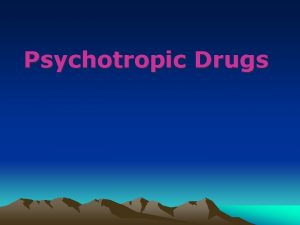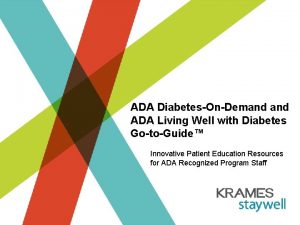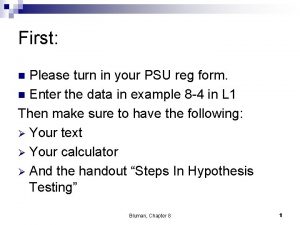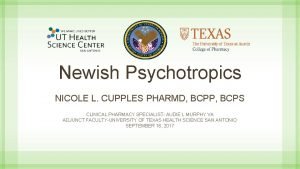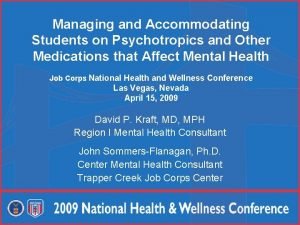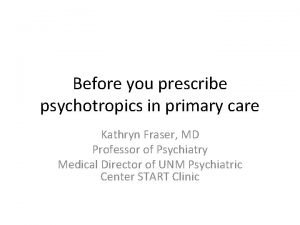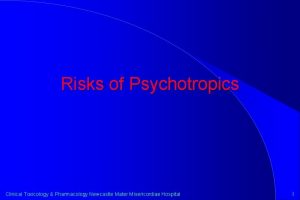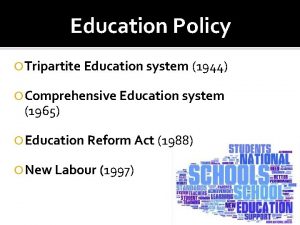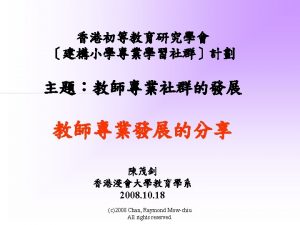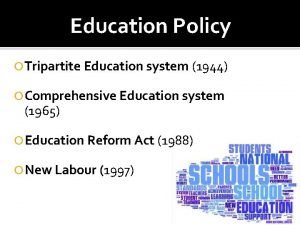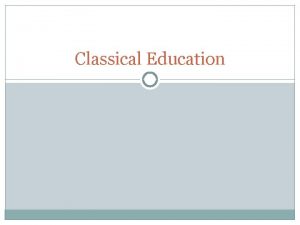P I E C E S Education Psychotropics
































- Slides: 32

P. I. E. C. E. S. Education Psychotropics Framework

What are the challenges? • Which medication works for which behaviour? • Right dose? • Side effects? • Tapering off medication • Changing medication • How long before we see desired effect? • Drug interactions • MDs not familiar with psychotropics • Colleagues wanting a quick fix • “Haldol Wobble” • Colleagues with differing opinions about meds • Not giving enough time for desired effect • Difficult to monitor

Psychotropic Use: Part of the Overall Approach Remember! 1. Always work through the overall P. I. E. C. E. S. framework and use psychotropics within a comprehensive approach. 2. Use supporting tools that will help you in detecting, selecting, and effecting.

Remember! Always use the problem solving template! 1. What has Changed? Think atypical! 2. What are the Risks &Causes? 3. What is the Action? • Investigation • Interaction • Intervention

Remember! Team and Comprehensive Approach • Informed and involved: Person and family at the centre. • Informed interdisciplinary and intersectoral providers working together and sharing information. “Prevent the preventable; support the supportable, treat the treatable. ” (Duncan Roberston)

What is my role?

Psychotropic Framework (within the context of the 3 -Q Template) 1. Detect: When should a psychotropic be used or considered? 2. Select: How do I contribute to the selection of the right medication? 3. Effect: How do I monitor the response and side effects?

Three Reasons to Use a Psychotropic 1. For a specific mental health disorder (e. g. depression, schizophrenia etc) 2. For a specific behaviour associated with a mental health disorder (e. g. behaviour associated with dementia) 3. As an adjunct (supportive) therapy (e. g. delirium)

Five Classes of Psychotropics 1. 2. 3. 4. 5. Antidepressants Antipsychotics Anxiolytics Mood Stabilizers Cognitive Enhancers

Depression Detect Flags for possible Depression v functional decline outstrips cognitive & medical problems v v v anhedonia, lack of reactivity psychomotor changes history: family or self anxiety psychosis Screening Tools v SIG E CAPS v Cornell Scale for Depression

Depression Select Determining which medication is best for the person. “Know the side effects”

Effect: Antidepressants Selection and Monitoring Class Tricyclic SIDE EFFECTS requiring monitoring: a) (C)ardiovascular - orthostatic hypotension, falls & pulse Remember the 3 C’s i. e. , Nortriptyline Desiprami ne b) Anti(C)holinergic 1) urinary retention 2) constipation 3) dry mouth, blurred vision c) (C)onfusion - monitor with CAM, Clock Test/Folstein

Effect: Antidepressants Class SSRI e. g. Citalopram SNRI SIDE EFFECTS requiring monitoring: Remember the HANDS Headache Agitation Nausea Diarrhea Sweating, Somnolence Headache, nausea, elevated BP e. g. Venlafaxine SARI e. g. Trazadone NASA e. g. Mitrazapine Drowsiness and orthostatic hypotension Noradrenergic and specific serotonergic antidepressant

Effect: Antidepressants Class SIDE EFFECTS requiring monitoring: NDRI i. e. Bupropion Remember SHARES a) Seizures b) Headache c) Agitation d) Rash e) Emesis f) Sleep disturbance MAOI i. e. Moclobemide Older ones (Parnate, Nardil) require special diet as the wrong food may cause a hypertensive crisis (Tyramine reaction). All MAOI should be monitored for hypotensive effects. Stimulants Cardiovascular, i. e. , high BP, agitation, i. e. Methylphenidate sleeplessness

Effect: Course of Recovery From Depression Response Character 2 -3 weeks: 3 -4 weeks: 6 -8 weeks: Improved sleep, appetite, vegetative shifts objective improvement energy suicidal ideation may subjective improvement

Antipsychotics Detect: When should it be considered? Clinical purpose: (1) Delusional disorders (2) Dementia with behavioural problems (3) Psychosis in depression (4) Delirium

Detect: When to Use the 7 D’s 1. Dangerous 2. Distressing 3. Disturbing 4. Jeopardizing Independence 5. Direct Action (Acting on them) 6. Distant vs Present 7. Definite (fixed)

Newer /Novel/Atypical Antipsychotics Select Less effects on: • EPS • Tardive dyskinesia • Cognition A different set of concerns: • Diabetes control/weight gain, cholesterol levels • In dementia increase mortality? • In dementia, risk of cardiovascular events?

Parkinson’s-Like Symptoms • • Tremor Akinesia Akathisia Rigidity (cogwheel) Drooling Pisa Sign Rabbit Sign Gait disturbance

Newer Antipsychotics: Effect DASH Dizziness – Agitation - Somnolence - Hypotension Olanzapine (anticholinergic) may cause weight gain, diabetic dyscontrol Risperidone may cause EPS at higher doses Quetiapine watch for sedation

Guidelines for Dosages in Dementia • • Risperdone 0. 25 to 1. 5 Target 1. 0 mg Olanzapine 2. 5 to 10 mg Quetiapine 25 – 125 mg Note: may need to use higher dosages (200 -300 mg) for Quetiapine; always titrate to response and tolerability: GO SLOW

Effect: 7 D’s Revisited Symptom Resolution: Dose - Response Behavioural Disturbances/Psychosis Clinical Monitoring Factor Time in Weeks Dangerous Distressing Acting on them Past vs Present Disturbing Fixed

Other Classes Anxiolytics Mood stabilizers Cognitive enhancers

Anxiolytics • Benzodiazepines • Avoid longer acting medications if possible (eg. Valium, Dalmane) • Dependency/ withdrawal effects • Side Effects: cognition, falls (ataxia), particularly on initiation and when increasing dose

Mood Stabilizers 1. Detect: Why is it being used or considered? - Detect Flag (Definitive, adjunctive) - Assist in selection STEPS (Safety, Tolerance, Efficacy, Price, Simplicity) 2. Select: How do I contribute to the Right Medication? - Lithium - Anti-epileptics 3. Effect: How do I monitor the response and side effects?

Mood Stabilizer Side Effects Require Monitoring Lithium Confusion, GI problems, weakness, polyuria, tremor Anti-epileptic e. g. Valproic Acid Carbamazepine Lamotrigine Gabapentin Sedation, ataxia, nausea; if there is a rash, bruising or bleeding of any type, call physician. (Serious rashes have been reported especially with Lamotrigine. ) Check if drug levels & blood work done regularly (liver, haematology) Gabapentin has a wide range of dosage. Used in neuropathic pain

Cognitive Enhancers • Detect: When should a cognitive enhancer be used or considered? • Class – Cholinesterase Inhibitors - Donepezil - Rivastigmine - Galantamine • Class - Glutaminergic - Memantine

Detect: Who May Benefit from Cognitive Enhancers? – Dementia of Alzheimer type Early to Moderately Severe (cholinergic) – Moderate to Severe A. D. (Memantine) – Lewy Body Dementia – Mixed Dementia – Other neuropsychiatric disorders

Cognitive Enhancers Select and Effect • Abilities • Behaviour • Cognition • Decrease in caregiver time • Entry into Nursing Home

Cholinergics Effect “MIND” Common 1. Muscle Cramps 2. Insomnia 3. Nausea 4. Diarrhea

Cholinergics: Mindful Seizures Supraventricular Dysfunction Sick Sinus Anesthesia Low Pulse Respiratory Dysfunction Asthma GI Upset (Peptic Ulcer NSAIDS) P. I. E. C. E. S. 31

Glutaminergic Agents (memantine): CHECK for common side effects Confusion Headache Equilibrium (dizziness) Constipation Kidney function
 Psychotropics
Psychotropics Formal education and non formal education venn diagram
Formal education and non formal education venn diagram Difference between health promotion and health education
Difference between health promotion and health education Backbone of extension education
Backbone of extension education The way of mindful education
The way of mindful education Hkul booking
Hkul booking Deped order no 39 s 2016
Deped order no 39 s 2016 Skinner theory
Skinner theory William shakespeare educational background
William shakespeare educational background Dep environmental education grants
Dep environmental education grants Ecec salt river
Ecec salt river History of physical education in greece
History of physical education in greece Integration in education
Integration in education Gifted education
Gifted education 2014 pearson education inc
2014 pearson education inc Sohu stock price
Sohu stock price Cornell executive education
Cornell executive education Clovis unified preschool
Clovis unified preschool Dudley allen
Dudley allen Education purposes only
Education purposes only Ryan sex education
Ryan sex education Department of education single sign on
Department of education single sign on 2011 pearson education inc
2011 pearson education inc Professional development for teachers
Professional development for teachers Living well with diabetes krames patient education
Living well with diabetes krames patient education Education and training career cluster definition
Education and training career cluster definition The medical rehabilitation education foundation reports
The medical rehabilitation education foundation reports Guardian school jobs
Guardian school jobs Barriers to inclusive education
Barriers to inclusive education What is curriculum in education
What is curriculum in education Qsen phases
Qsen phases Authentic assessment in physical education
Authentic assessment in physical education 2014 pearson education inc
2014 pearson education inc
